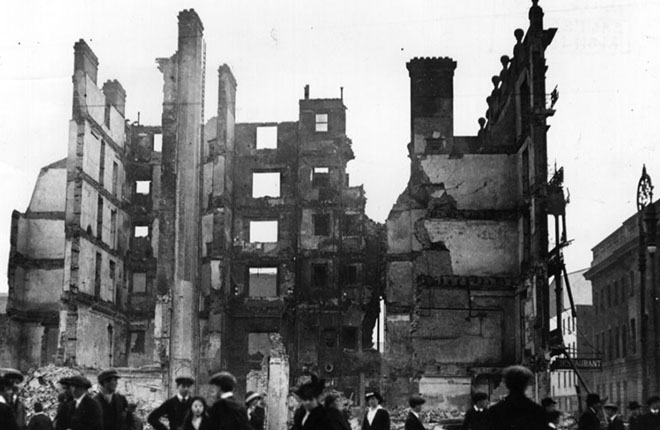This month sees the centenary of the 1916 Easter Rising, the first organised military operation against British rule in Ireland since the 18th century. Although it was suppressed after six days and its leaders executed, it was the turning point in Irish history, and through a mixture of election victories and armed rebellion, Ireland gained independence from Britain in 1919: except that the British did not surrender Northern Ireland, which remains home to an imported population of Scots-Irish Protestants who do not support independence from Britain and do not identify themselves as Irish.
A political party representing the Republican movement at that time was Sinn Féin, which means ‘Ourselves’ in Irish Gaelic. In the 1970s it was revived, and also had another name: ‘the political wing of the Provisional Irish Republican Army’. Today, the party is led by Martin McGuiness in Northern Ireland and Gerry Adams in the Republic of Ireland. Both these men are former terrorists, Adams having been Chief of Staff of the Provisional IRA in 1977-78, and McGuiness having succeeded him from 1978 to 1982. These were not symbolic positions: this was a period of undeclared civil war, and these men were actively involved in bombings and assassinations on a large scale. The Provos also ran a kind of unofficial justice system, making extensive use of ‘kneecapping’ – shooting people through the knees – to punish those they saw as criminals in the areas of Northern Ireland under their control.
On the other hand, it was these same men who undertook the negotiations with the British Government that led to the Good Friday peace agreement of 1998, something seen as a great achievement by everyone in Britain, Ireland and the world, with the United States – home to more Irish people than live in Ireland – also closely involved. Irish-Americans had provided money and weapons to the IRA since the 1920s. The violence went on for so long that it came to seem normal, but once it was over British and Irish people alike understood what a black cloud had hung over Northern Ireland for so long. The British Army lost over 600 men in the 38 years of Operation Banner from 1969 to 2007: the longest operation in its history.
The Republic of Ireland has just held inconclusive elections, and at present it looks as if fresh elections will be necessary as no workable coalition has emerged. In May there will also be elections for the Northern Ireland Assembly. Sinn Féin is the only party offering candidates on both sides of the border. Its electoral success has led Dimitris Papadimoulis, the leader of Syriza’s MEPs in Brussels, to suggest that Sinn Féin is like Syriza in Greece, Podemos in Spain and Beppe Grillo’s movement in Italy: part of a Europe-wide anti-austerity movement. Papadimoulis claims that Sinn Féin ‘will define mainstream politics in Ireland from now on’.
This is an exaggerated claim, and typical of the romantic ideas that people outside the British Isles have about these issues. There is nothing charming or romantic about the IRA.
The politics of Ireland does not follow the normal European pattern. Maybe it’s because Ireland was neutral in the Second World War, so that like Switzerland it is an anomaly. Rather than finding itself polarized on the left-right axis of the post-war European order, it was left fighting another war – its own Civil War, that divided Ireland into two rival political families in the 1920s. The question then was whether Ireland should be an independent republic, or whether it should accept the ‘Free State’ model and thus remain part of the British Empire. The two main parties in Irish politics today are still the parties that represented these two sides: Fianna Fáil (‘Soldiers of Destiny’), still also called The Republican Party, and Fine Gael (‘Brothers of Ireland’), which had represented the Free State alternative. On the left there is also the Labour Party, a standard democratic socialist group, and Sinn Féin, which apart from its Republican identity also has a Marxist agenda.
It is often said that McGuinness and Adams need to keep going as political leaders, as this protects them from prosecution for the many acts of terrorism they were responsible for decades ago. It is certainly true that they are immune from prosecution in their present positions.
In the North, Sinn Féin just has to wait. The peace process has done nothing to change the fundamental fact about Northern Ireland: it is a divided society, especially in terms of education and marriage. But the balance of power has been gradually shifting for decades. It used to be completely dominated by the Protestants, with the Catholics thought of as illiterate peasants. But two out of three university students are now Catholic, and the final argument is the demographic one. The Catholics have more children, and are currently at approximate parity. Soon they will become the majority population.
In the Republic, the Catholic connection with Sinn Féin evaporates. In the North, being a Catholic has a strong political connotation. In the South, the Irish are rapidly falling out of love with their traditional religion, largely because of sexual abuse scandals involving priests. (Church attendance was 90% in 1984; now about 30%.) From a political perspective, those with long memories will also remember that the Catholic Church in Ireland was on the side of the Free State and the British until forced to accept the Republican victory. Sinn Féin’s advance is due to other factors completely.
Fianna Faíl, the party of Éamon de Valera and the original Irish Republican Army, has been the natural party of government in Ireland ever since independence, but when Ireland’s membership of the European Union created an incredible wave of prosperity in a country that had always been poor, Fianna Faíl tried to reinvent itself as a party of capitalism. This means that it quite rightly got the blame when the house of cards collapsed in the international credit crisis. The Fianna Fáil government sought to bail out the banks rather than helping individuals: and as in many other countries, that was the wrong answer. Fianna Faíl’s performance in the 2011 elections was the worst in its history, and it did not recover in 2016. While Sinn Féin didn’t pick up all the extra votes, the hard men from the North have one great advantage. They are not corrupt. They are purists and ideologues, and to that extent people know that they are trustworthy. Sinn Féin demands that its members of parliament live on the average industrial wage. Nobody can accuse them of profiteering.
There is a strange result in all this. In Northern Ireland, there is a political environment of tactical manoeuvres. In the South, it is a question of coalitions. On both sides of the border, Sinn Féin needs to adapt to the local conditions and take positions on all the many issues that come up in day to day politics: economic policy, the health service, water rates… and their ideological purity suddenly seems a detail. Fianna Fáil and Fine Gael started out with just as much nationalistic fervour. After its long and bloody road to power, Sinn Féin is ending up as just another Irish political party.
What guarantees this destiny is one simple factor. The Provisional IRA and Sinn Féin had one essential aim: a united Ireland. This explains why Sinn Féin is active both in the Republic and in Northern Ireland, as a steady minority in both parts of Ireland still support the idea of unification. But it is now very unlikely that this will ever happen. The political compromise in Northern Ireland has definitely improved the general situation there, but has done nothing to reduce the atmosphere of hatred in which Catholics and Protestants grow up. Hatred is part of working class identity on both sides, and children grow up learning to make petrol bombs and sing about killing their rivals. There are not just separate schools but separate bus stops for Catholics and Protestants in Belfast, and high walls separate their houses. A specific and very serious problem is that some Republicans now feel cheated by the Provisional IRA and Sinn Féin, saying they have joined the British government occupation of Northern Ireland. These dissidents have decided to re-start the conflict, with a new political movement, the 32 counties or 32C movement to explain their reasoning in public. For the time being there have been only a few bombs and shootings aimed at police, soldiers and the MI5 base in Belfast, but they are highly visible in working class areas north and south of the border due to their war against drug dealers. During the boom years in Ireland, the cocaine business took off, and the dissident Republican groups declared war against the organised criminal gangs who also deal in heroin and other drugs. On February 2 a group of gunmen disguised as policemen opened fire at a gangland boxing event in a Dublin hotel with AK-47s that seem to have come from IRA sources.
The Irish government is planning a whole series of ceremonial events to celebrate 100 years since the 1916 Easter Rising. Sinn Féin will certainly want to join in these celebrations. But the British government fears that there might be a different kind of commemoration too. It is reported that the dissidents of the so-called ‘Real IRA’ might want to mark the centenary with a bombing campaign. To quote from the MI5 website today: ‘The current threat level for Northern Ireland-related terrorism in Northern Ireland is SEVERE’.





